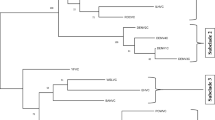Summary
The plaques formed by wild-type (WT) populations of strain K485 visna (V-K485) virus, strain K796 visna (V-K796) virus, and of progressive pneumonia virus in sheep choroid plexus (SCP) cell cultures are heterogeneous in size. Plaque purification procedures showed that this heterogeneity was due to the presence of two biologically different viruses, large plaque-forming (Lpf) virus and small plaque-forming (Spf) virus. The V-K796 Lpf virus, the V-K796 Spf virus, and the V-K796 WT virus are antigenically similar to each other. Although the V-K796 Spf virus is less cytopathic than the V-K796 Lpf virus, both viruses have a 14- to 16-hour latent period in SCP cells and have similar rates of synthesis for the initial 24 to 30 hours after infection. The V-K796 Spf virus is considered a temperature-sensitive visna virus since, unlike the V-K796 Lpf virus, it does not produce plaques at 41° C and it is more thermosensitive than the V-K796 Lpf variant. Population analyses of two strains of wild-type visna virus and one strain of progressive pneumonia virus demonstrated that these populations contain variants with the phenotypes of V-K796 Spf virus and V-K796 Lpf virus, that the Spf virus was not selected against in sheep, and that cultivation of the wild type visna viruses at 37° C selected against the temperature-sensitive variants. The existence of the temperature-sensitive Spf viruses in these wild-type virus populations suggests that the Spf variants maintain the persistent visna virus infection in sheep and delay the development of the host's cell-mediated immune response to the viral proteins.
Similar content being viewed by others
References
Adalsteinsson, S.: Historical data on Iceland's sheep industry. The National Wool Grower56, 10–11 (1966).
Clements, J. C., D'Antonio, N., Narayan, O.: Isolation and preliminary characterization of temperature-sensitive mutants of visna virus. Virology102, 46–53 (1980).
Dalton, A. J., Melnick, J. L., Bauer, H., Beaudreau, G., Bentvelzen, P., Bolognesi, D., Gallo, R., Graffi, A., Haguenau, F., Heston, W., Huebner, R., Todaro, G., Heine, U. I.: The case for a family of reverse transcriptase viruses: Retraviridae. Intervirology4, 201–206 (1974).
Gudnadottir, M., Palsson, P. A.: Host-virus interaction in visna virus infected sheep. J. Immunol.95, 1116–1120 (1966).
Haase, A. T.: The slow infection caused by visna virus. Current Topics in Microbiology and Immunology72, 101–156 (1975).
Ham, R. G., Puck, T. T.: Quantitative colonial growth of isolated mammalian cells. In:Colowick, S. P., Kaplan, N. O. (eds.), Methods in Enzymology, Vol. 5, 90–119. New York: Academic Press 1962.
Harter, D. H., Choppin, P. W.: Cell-fusing activity of visna virus particles. Virology31, 279–288 (1967).
Horowitz, M. S., Scharff, M. D.: The production of antiserum against viral antigens. In:Habel, K., Salzman, N. P. (eds.), Fundamental Techniques in Virology, 253–262. New York: Academic Press 1969.
Lin, F. H., Thormar, H.: On visna virus: purification and nucleic acid content. Virology42, 1140–1143 (1970).
Lin, F. H., Thormar, H.: Ribonucleic acid-dependent deoxyribonucleic acid polymerase in visna virus. J. Virol.6, 702–704 (1970).
Lin, F. H., Thormar, H.: Characterization of ribonucleic acid from visna virus. J. Virol.7, 582–587 (1971).
Panitch, H., Petursson, G., Georgsson, G., Palsson, P., Nathanson, N.: Pathogenesis of visna. II. Effect of immunosuppression upon early central nervous system lesion. J. Neuropath. Exp. Neurol.35, 337 (1976).
Preble, O. T., Youngner, J. S.: Temperature-sensitive viruses and the etiology of chronic and inapparent infections. J. inf. Dis.131, 467–473 (1975).
Sigurdsson, G., Palsson, P. A., Grimsson, H.: Visna, a demyelinating transmissible disease of sheep. J. Neuropathol. Exp. Neurol.16, 389–403 (1957).
Sigurdsson, B., Palsson, P. A.: Visna of sheep. A slow demyelinating infection. Brit. J. exp. Neurol.39, 519–528 (1958).
Sigurdsson, B., Thormar, H., Palsson, P. A.: Cultivation of visna virus in tissue culture. Arch. ges. Virusforsch.10, 368–381 (1960).
Takemoto, K. K., Mattern, C. F. T., Stone, L. B., Coe, J. E., Lavelle, G.: Antigenic and morphological similarities of progressive pneumonia virus, a recently isolated “slow virus” of sheep, to visna and maedi viruses. J. Virol.7, 301–308 (1971).
Thormar, H., Helgadottir, H.: A comparison of visna and maedi viruses. II. Serological relationships. Res. Vet. Sci.6, 456–465 (1965).
Thormar, H., Palsson, P. A.: Visna and Maedi—two slow infections of sheep and their etiological agents. In:Pollard, M. (ed.), Perspectives in Virology, Vol. 5, 291–308. New York: Academic Press 1967.
Thormar, H.: Visna and maedi virus antigens in infected cell cultures studied by the fluorescent antibody technique. Acta Path. Microbiol. Scandinav.75, 296–302 (1969).
Torchio, C., Trowbridge, R. S.: Ovine cells: their long-term cultivation and susceptibility to visna virus. In Vitro13, 252–259 (1977).
Trowbridge, R. S.: Evaluation of a plaque assay for the maedi-progressive pneumonia-visna viruses. Applied Microbiol.28, 366–373 (1974).
Trowbridge, R. S.: Long-term visna virus infection of sheep choroid plexus cells: initiation and preliminary characterization of the carrier cultures. Infect. Immun.11, 862–868 (1975).
Trowbridge, R. S.: One-cycle growth studies with maedi-progressive pneumoniavisna viruses: shorter latent periods revealed. Comp. Immunol., Microbiol. and Infec. Dis.2, 545–550 (1979).
Wang, C., Smith, R. L.: Determination of protein in the presence of nonidet P40 or triton × 100 by a modified procedure. Anal. Biochem.63, 414–417 (1975).
Wecker, E.: A simple test for serodifferentiation of poliovirus strains within the same type. Virology10, 376–379 (1960).
Author information
Authors and Affiliations
Additional information
With 4 Figures
Rights and permissions
About this article
Cite this article
Trowbridge, R.S., Lehmann, J., Torchio, C. et al. Wild-type temperature-sensitive and -resistant visna viruses: Isolation and biological comparison. Archives of Virology 67, 229–240 (1981). https://doi.org/10.1007/BF01318133
Received:
Accepted:
Issue Date:
DOI: https://doi.org/10.1007/BF01318133




